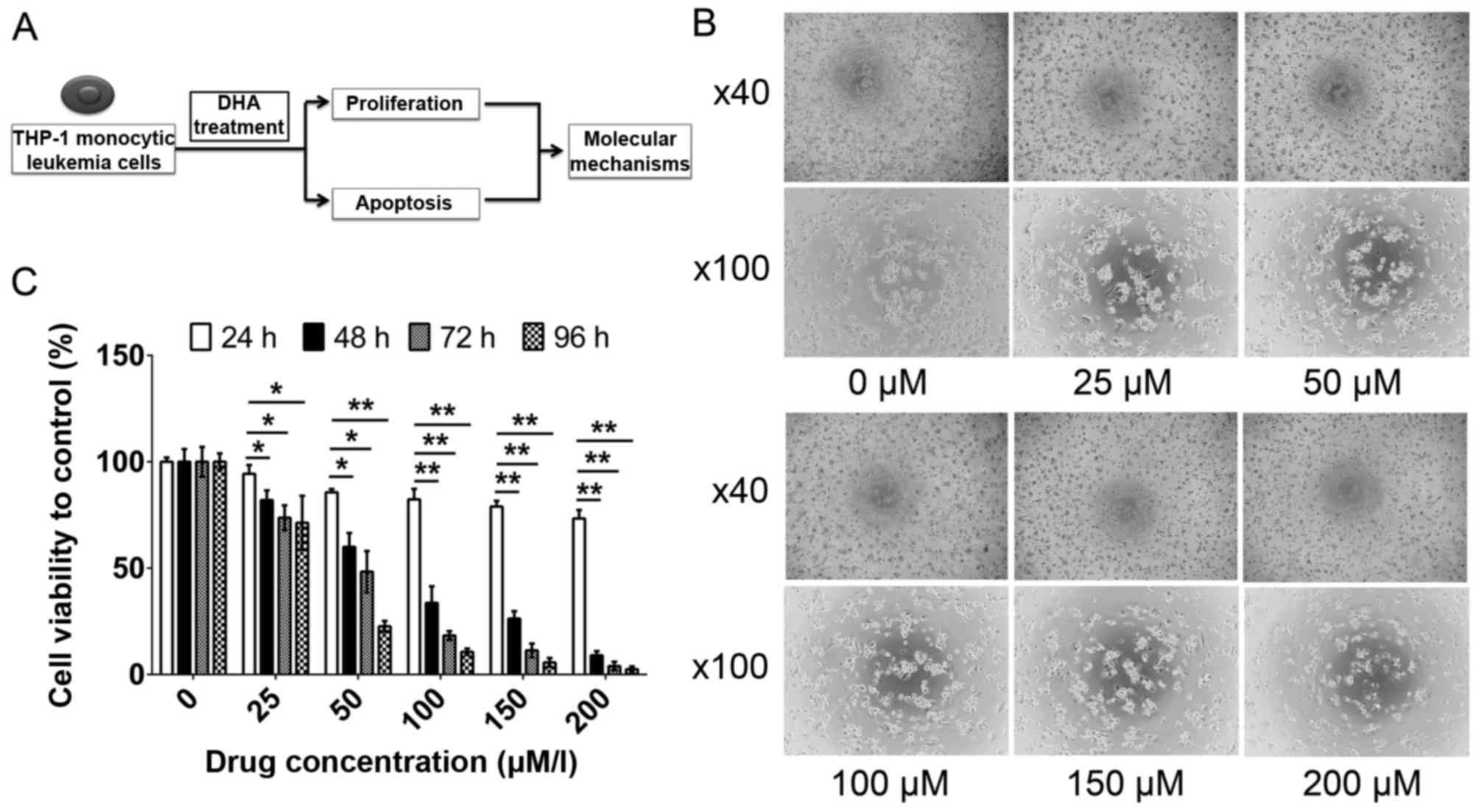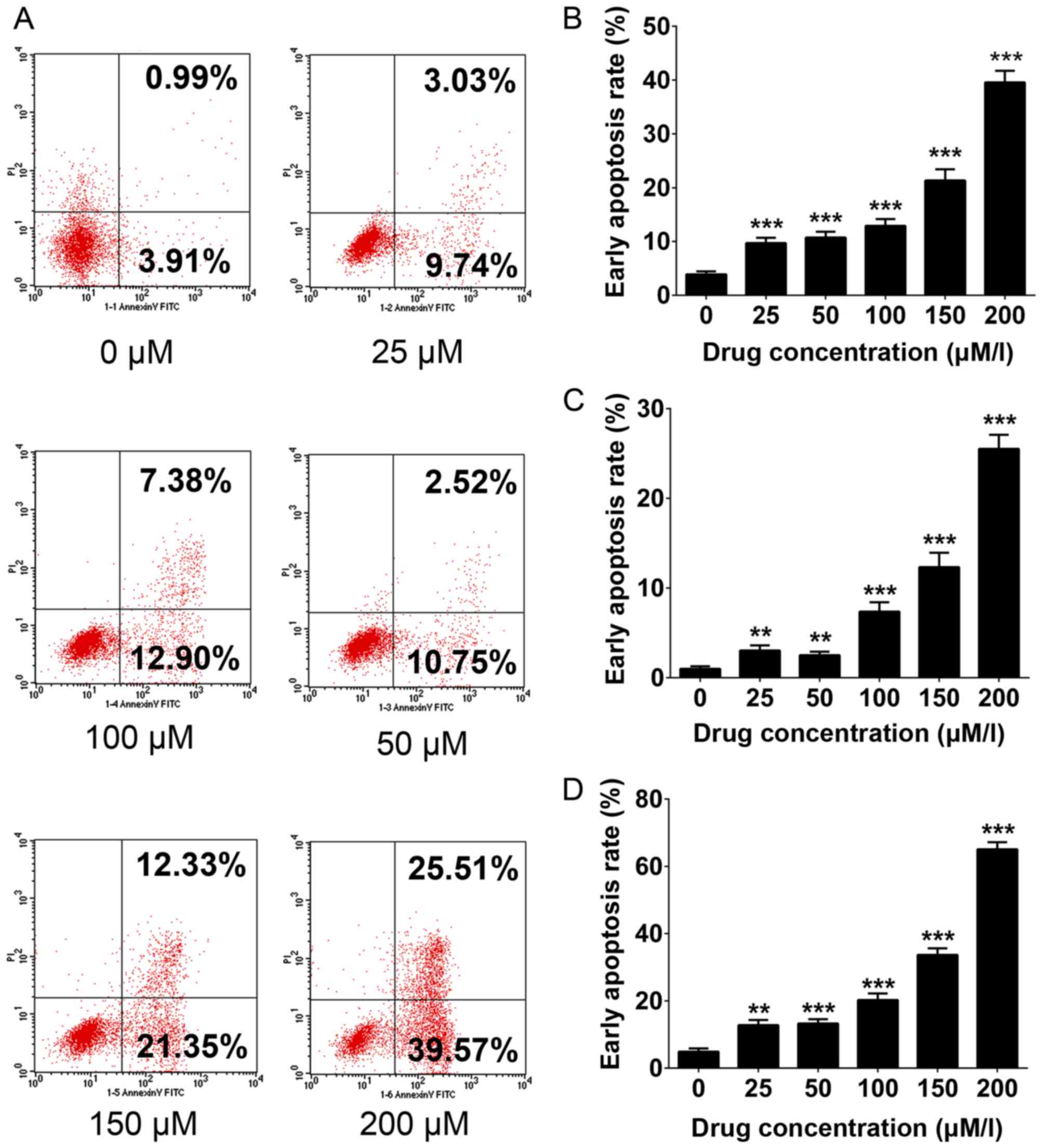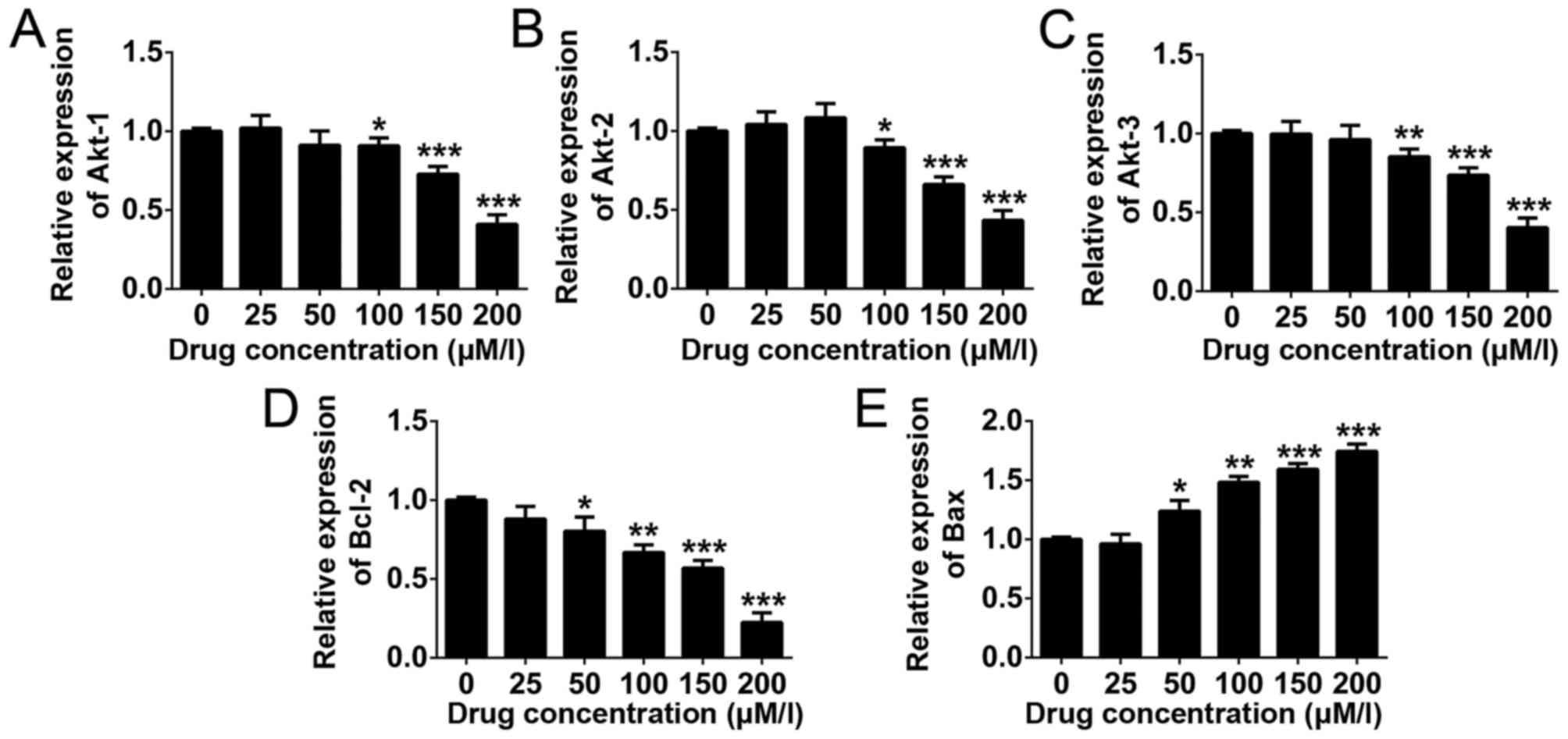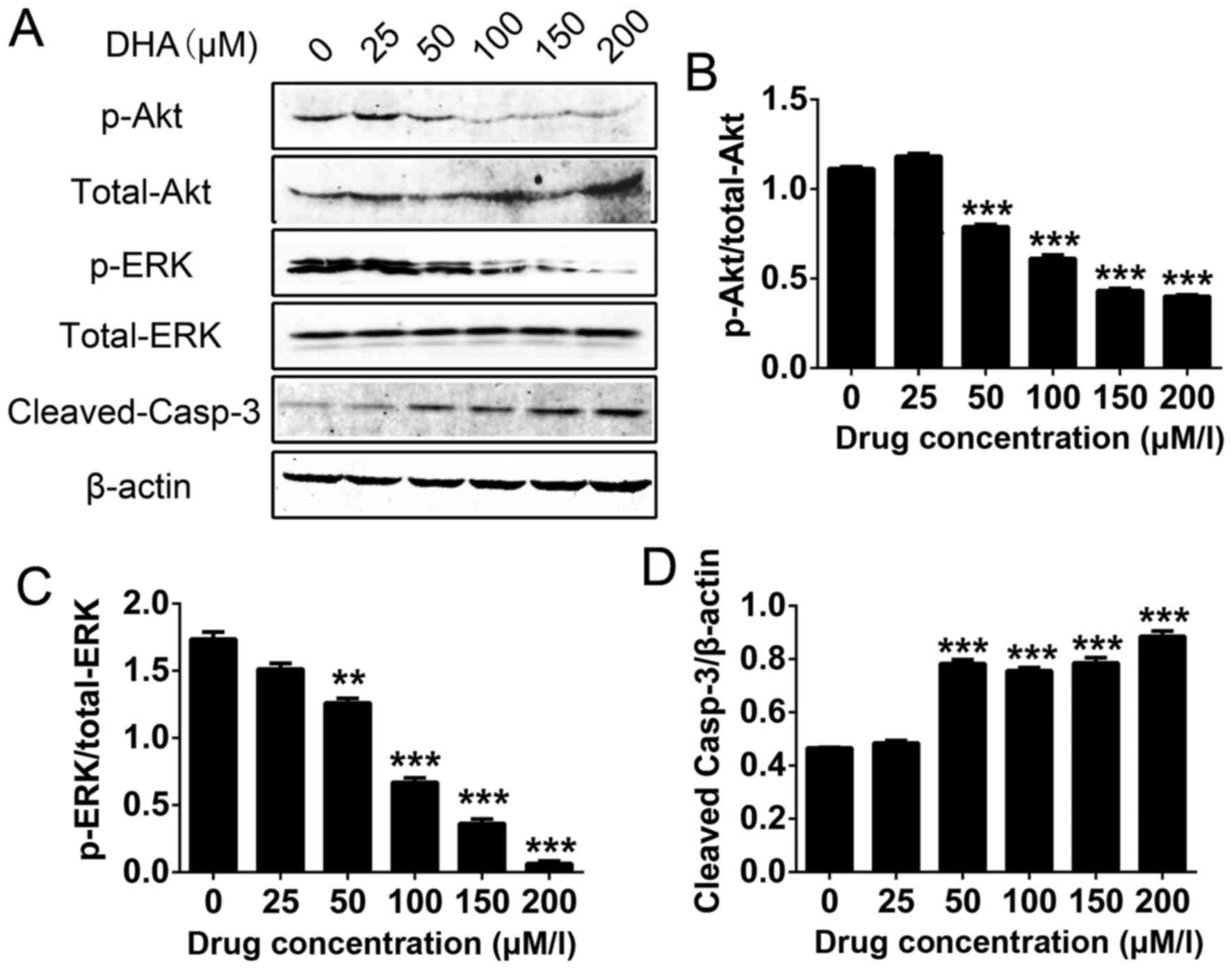|
1
|
Ommen HB: Monitoring minimal residual
disease in acute myeloid leukaemia: A review of the current
evolving strategies. Ther Adv Hematol. 7:3–16. 2016. View Article : Google Scholar : PubMed/NCBI
|
|
2
|
Peng H, Wang H, Xue P, Hou Y, Dong J, Zhou
T, Qu W, Peng S, Li J, Carmichael PL, et al: Suppression of
NRF2-ARE activity sensitizes chemotherapeutic agent-induced
cytotoxicity in human acute monocytic leukemia cells. Toxicol Appl
Pharmacol. 292:1–7. 2016. View Article : Google Scholar : PubMed/NCBI
|
|
3
|
Guo Y, Shan Q, Gong Y, Lin J, Shi F, Shi R
and Yang X: Curcumin induces apoptosis via simultaneously targeting
AKT/mTOR and RAF/MEK/ERK survival signaling pathways in human
leukemia THP-1 cells. Pharmazie. 69:229–233. 2014.PubMed/NCBI
|
|
4
|
Ozpolat B, Akar U, Steiner M,
Zorrilla-Calancha I, Tirado-Gomez M, Colburn N, Danilenko M,
Kornblau S and Berestein GL: Programmed cell death-4 tumor
suppressor protein contributes to retinoic acid-induced terminal
granulocytic differentiation of human myeloid leukemia cells. Mol
Cancer Res. 5:95–108. 2007. View Article : Google Scholar : PubMed/NCBI
|
|
5
|
Murashige N, Tabanda R and Zalusky R:
Occurrence of acute monocytic leukemia in a case of untreated
Waldenstrom's macroglobulinemia. Am J Hematol. 71:94–97. 2002.
View Article : Google Scholar : PubMed/NCBI
|
|
6
|
Cline MJ: Histiocytes and histiocytosis.
Blood. 84:2840–2853. 1994.PubMed/NCBI
|
|
7
|
Kumar RK, Basu S, Lemke HD, Jankowski J,
Kratz K, Lendlein A and Tetali SD: Effect of extracts of poly(ether
imide) microparticles on cytotoxicity, ROS generation and
proinflammatory effects on human monocytic (THP-1) cells. Clin
Hemorheol Microcirc. 61:667–680. 2016. View Article : Google Scholar : PubMed/NCBI
|
|
8
|
Li Y: Qinghaosu (artemisinin): Chemistry
and pharmacology. Acta Pharmacol Sin. 33:1141–1146. 2012.
View Article : Google Scholar : PubMed/NCBI
|
|
9
|
Lin AJ, Klayman DL and Milhous WK:
Antimalarial activity of new water-soluble dihydroartemisinin
derivatives. J Med Chem. 30:2147–2150. 1987. View Article : Google Scholar : PubMed/NCBI
|
|
10
|
Ashley EA, McGready R, Hutagalung R,
Phaiphun L, Slight T, Proux S, Thwai KL, Barends M, Looareesuwan S,
White NJ and Nosten F: A randomized, controlled study of a simple,
once-daily regimen of dihydroartemisinin-piperaquine for the
treatment of uncomplicated, multidrug-resistant falciparum malaria.
Clin Infect Dis. 41:425–432. 2005. View
Article : Google Scholar : PubMed/NCBI
|
|
11
|
Gordi T and Lepist EI: Artemisinin
derivatives: Toxic for laboratory animals, safe for humans? Toxicol
Lett. 147:99–107. 2004. View Article : Google Scholar : PubMed/NCBI
|
|
12
|
Mi YJ, Geng GJ, Zou ZZ, Gao J, Luo XY, Liu
Y, Li N, Li CL, Chen YQ, Yu XY and Jiang J: Dihydroartemisinin
inhibits glucose uptake and cooperates with glycolysis inhibitor to
induce apoptosis in non-small cell lung carcinoma cells. PLoS One.
10:e01204262015. View Article : Google Scholar : PubMed/NCBI
|
|
13
|
Liu W, Wang DW, Yu SY, Cao Y, Yang L, E
XQ, Yao GJ and Bi ZG: The effect of dihydroartemisinin on the
proliferation, metastasis and apoptosis of human osteosarcoma cells
and its mechanism. J Biol Regul Homeost Agents. 29:335–342.
2015.PubMed/NCBI
|
|
14
|
Feng X, Li L, Jiang H, Jiang K, Jin Y and
Zheng J: Dihydroartemisinin potentiates the anticancer effect of
cisplatin via mTOR inhibition in cisplatin-resistant ovarian cancer
cells: Involvement of apoptosis and autophagy. Biochem Biophys Res
Commun. 444:376–381. 2014. View Article : Google Scholar : PubMed/NCBI
|
|
15
|
Park J, Lai HC, Singh M, Sasaki T and
Singh NP: Development of a dihydroartemisinin-resistant Molt-4
leukemia cell line. Anticancer Res. 34:2807–2810. 2014.PubMed/NCBI
|
|
16
|
Chan HW, Singh NP and Lai HC: Cytotoxicity
of dihydroartemisinin toward Molt-4 cells attenuated by
N-tert-butyl-alpha-phenylnitrone and deferoxamine. Anticancer Res.
33:4389–4393. 2013.PubMed/NCBI
|
|
17
|
Schmittgen TD and Livak KJ: Analyzing
real-time PCR data by the comparative C(T) method. Nat Protoc.
3:1101–1108. 2008. View Article : Google Scholar : PubMed/NCBI
|
|
18
|
Zhang D, Wang Q, Zhu T, Cao J, Zhang X,
Wang J, Wang X, Li Y, Shen B and Zhang J: RACK1 promotes the
proliferation of THP1 acute myeloid leukemia cells. Mol Cell
Biochem. 384:197–202. 2013. View Article : Google Scholar : PubMed/NCBI
|
|
19
|
Zeng C, Wang W, Yu X, Yang L, Chen S and
Li Y: Pathways related to PMA-differentiated THP1 human monocytic
leukemia cells revealed by RNA-Seq. Sci China Life Sci.
58:1282–1287. 2015. View Article : Google Scholar : PubMed/NCBI
|
|
20
|
Evans FJ and Hilton JH: Polymyositis
associated with acute Nonocytic leukemia: Case report and review of
the literature. Can Med Assoc J. 91:1272–1275. 1964.PubMed/NCBI
|
|
21
|
Wang Y, Ma L, Wang C, Sheng G, Feng L and
Yin C: Autocrine motility factor receptor promotes the
proliferation of human acute monocytic leukemia THP-1 cells. Int J
Mol Med. 36:627–632. 2015. View Article : Google Scholar : PubMed/NCBI
|
|
22
|
Jain SK, Sahu R, Walker LA and Tekwani BL:
A parasite rescue and transformation assay for antileishmanial
screening against intracellular Leishmania donovani amastigotes in
THP1 human acute monocytic leukemia cell line. Journal of
visualized experiments. 70:e40542012.
|
|
23
|
Tu YY: TU You-you won Lasker Debakey
clinical medical research award-for her outstanding achievements in
studies on artemisinin. Zhongguo Zhong Xi Yi Jie He Za Zhi.
31:13012011.(In Chinese). PubMed/NCBI
|
|
24
|
Dong YJ, Li WD and Tu YY: Effect of
dihydro-qinghaosu on auto-antibody production, TNF alpha secretion
and pathologic change of lupus nephritis in BXSB mice. Zhongguo
Zhong Xi Yi Jie He Za Zhi. 23:676–679. 2003.(In Chinese).
PubMed/NCBI
|
|
25
|
Zhang CZ, Zhang H, Yun J, Chen GG and Lai
PB: Dihydroartemisinin exhibits antitumor activity toward
hepatocellular carcinoma in vitro and in vivo. Biochem Pharmacol.
83:1278–1289. 2012. View Article : Google Scholar : PubMed/NCBI
|
|
26
|
Feng MX, Hong JX, Wang Q, Fan YY, Yuan CT,
Lei XH, Zhu M, Qin A, Chen HX and Hong D: Dihydroartemisinin
prevents breast cancer-induced osteolysis via inhibiting both
breast cancer cells and osteoclasts. Sci Rep. 6:190742016.
View Article : Google Scholar : PubMed/NCBI
|
|
27
|
Wang Z, Hu W, Zhang JL, Wu XH and Zhou HJ:
Dihydroartemisinin induces autophagy and inhibits the growth of
iron-loaded human myeloid leukemia K562 cells via ROS toxicity.
FEBS Open Bio. 2:103–112. 2012. View Article : Google Scholar : PubMed/NCBI
|
|
28
|
Zhao X, Zhong H, Wang R, Liu D, Waxman S,
Zhao L and Jing Y: Dihydroartemisinin and its derivative induce
apoptosis in acute myeloid leukemia through Noxa-mediated pathway
requiring iron and endoperoxide moiety. Oncotarget. 6:5582–5596.
2015.PubMed/NCBI
|
|
29
|
Lim SG, Suk K and Lee WH: Reverse
signaling from LIGHT promotes pro-inflammatory responses in the
human monocytic leukemia cell line, THP-1. Cell Immunol. 285:10–17.
2013. View Article : Google Scholar : PubMed/NCBI
|
|
30
|
Teng CL, Han SM, Wu WC, Hsueh CM, Tsai JR,
Hwang WL and Hsu SL: Mechanistic aspects of lauryl gallate-induced
differentiation and apoptosis in human acute myeloid leukemia
cells. Food Chem Toxicol. 71:197–206. 2014. View Article : Google Scholar : PubMed/NCBI
|
|
31
|
Shi D, Xu Y, Du X, Chen X, Zhang X, Lou J,
Li M and Zhuo J: Co-treatment of THP-1 cells with naringenin and
curcumin induces cell cycle arrest and apoptosis via numerous
pathways. Mol Med Rep. 12:8223–8228. 2015. View Article : Google Scholar : PubMed/NCBI
|
|
32
|
Olesen LH, Aggerholm A, Andersen BL,
Nyvold CG, Guldberg P, Nørgaard JM and Hokland P: Molecular typing
of adult acute myeloid leukaemia: Significance of translocations,
tandem duplications, methylation, and selective gene expression
profiling. Br J Haematol. 131:457–467. 2005. View Article : Google Scholar : PubMed/NCBI
|
|
33
|
Ruvolo PP, Qiu Y, Coombes KR, Zhang N,
Neeley ES, Ruvolo VR, Hail N Jr, Borthakur G, Konopleva M, Andreeff
M and Kornblau SM: Phosphorylation of GSK3α/β correlates with
activation of AKT and is prognostic for poor overall survival in
acute myeloid leukemia patients. BBA Clin. 4:59–68. 2015.
View Article : Google Scholar : PubMed/NCBI
|














